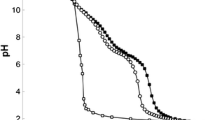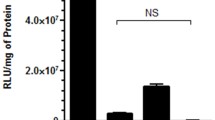Abstract
Receptor-binding ligands have been incorporated into DNA/polyethylenimine (PEI) complexes to enhance cell binding and cellular internalization. This study characterizes receptor-mediated uptake of DNA/PEI complexes on a cellular basis. A novel assay based on flow cytometry was applied, discriminating between total cell-associated and extracellularly bound DNA complexes. Receptor-mediated uptake of ligand-containing DNA/PEI (molecular weight, 800 kd) complexes was found to occur quickly (within 1 hour), whereas unspecific uptake through adsorptive endocytosis is less efficient or requires extended periods to reach the same degree of internalization. Rapid, receptor-mediated internalization requires a small complex size; however, large, aggregated complexes show higher gene expression. Using PEI 25 kd conjugated to large proteins such as transferrin or antibodies, improper condensation with DNA leads to suboptimal uptake and gene expression, whereas partial replacement of ligand-PEI with unconjugated PEI increases both uptake and transfection. In contrast, the 8 kd protein epidermal growth factor conjugated to PEI 25 kd properly condenses DNA and mediates specific uptake into human adenocarcinoma (KB) cells. Modification of the complex surface with appropriate amounts of poly(ethylene glycol) (PEG) does not block ligand-mediated internalization. A higher degree of PEGylation reduces the internalization of transferrin or antibody-containing complexes to a level similar to that of ligand-free complexes. In contrast, epidermal growth factor-mediated uptake is less effected by excessive PEGylation.
Similar content being viewed by others
References
Wu GY, Wu CH. Receptor-mediated gene delivery and expression in vivo. J Biol Chem. 1988;263:14621–14624.
Wu GY, Wu CH. Receptor-mediated in vitro gene transformation by a soluble DNA carrier system. J Biol Chem. 1987;262:4429–4432.
Plank C, Zatloukal K, Cotten M, Mechtler K, Wagner E. Gene transfer into hepatocytes using asialoglycoprotein receptor mediated endocytosis of DNA complexed with an artificial tetra-antennary galactose ligand. Bioconjug Chem. 1992;3:533–539.
Merwin JR, Noell GS, Thomas WL, et al. Targeted delivery of DNA using YEE(GalNAcAH)3, a synthetic glycopeptide ligand for the asialoglycoprotein receptor. Bioconjug Chem. 1994;5:612–620.
Remy JS, Kichler A, Mordvinov V, Schuber F, Behr JP. Targeted gene transfer into hepatoma cells with lipopolyaminecondensed DNA particles presenting galactose ligands: a stage toward artificial viruses. Proc Natl Acad Sci U S A. 1995;92:1744–1748.
Cotten M, Wagner E, Birnstiel ML. Receptor-mediated transport of DNA into eukaryotic cells. Methods Enzymol. 1993;217:618–644.
Kircheis R, Kichler A, Wallner G, et al. Coupling of cellbinding ligands to polyethylenimine for targeted gene delivery. Gene Ther. 1997;4:409–418.
Buschle M, Cotten M, Kirlappos H, et al. Receptor-mediated gene transfer into human T lymphocytes via binding of DNA/CD3 antibody particles to the CD3 T cell receptor complex. Hum Gene Ther. 1995;6:753–761.
Ferkol T, Perales JC, Eckman E, Kaetzel CS, Hanson RW, Davis PB. Gene transfer into the airway epithelium of animals by targeting the polymeric immunoglobulin receptor. J Clin Invest. 1995;95:493–502.
Sosnowski BA, Gonzalez AM, Chandler LA, Buechler YJ, Pierce GF, Baird A. Targeting DNA to cells with basic fibroblast growth factor (FGF2). J Biol Chem. 1996;271:33647–33653.
Xu B, Wiehle S, Roth JA, Cristiano RJ. The contribution of poly-L-lysine, epidermal growth factor and streptavidin to EGF/PLL/DNA polylex formation. Gene Ther. 1998;5:1235–1243.
Ogris M, Steinlein P, Carotta S, Brunner S, Wagner E. A versatile assay to study cellular uptake of gene transfer complexes by flow cytometry. Biochim Biophys Acta. 2000;1474:237–243.
Zanta MA, Boussif O, Adib A, Behr JP. In vitro gene delivery to hepatocytes with galactosylated polyethylenimine. Bioconjug Chem. 1997;8:839–844.
Erbacher P, Remy JS, Behr JP. Gene transfer with synthetic virus-like particles via the integrin-mediated endocytosis pathway. Gene Ther. 1999;6:138–145.
Kircheis R, Wightman L, Schreiber A, et al. Polyethylenimine/DNA complexes shielded by transferrin target gene expression to tumors after systemic application. Gene Ther. 2001;8:28–40.
Blessing T, Kursa M, Holzhauser R, Kircheis R, Wagner E. Different strategies for formation of PEGylated EGF-conjugated PEI/DNA complexes for targeted gene delivery. Bioconjug Chem. 2001; ASAP Article, Web release date: June 23, 2001.
Ogris M, Steinlein P, Kursa M, Mechtler K, Kircheis R, Wagner E. The size of DNA/transferrin-PEI complexes is an important factor for gene expression in cultured cells. Gene Ther. 1998;5:1425–1433.
Ogris M, Brunner S, Schuller S, Kircheis R, Wagner E. PEGylated DNA/transferrin-PEI complexes: reduced interaction with blood components, extended circulation in blood and potential for systemic gene delivery. Gene Ther. 1999;6:595–605.
Smythe E, Warren G. The mechanism of receptor-mediated endocytosis. Eur J Biochem. 1991;202:689–699.
Abdallah B, Hassan A, Benoist C, Goula D, Behr JP, Demeneix BA. A powerful nonviral vector for in vivo gene transfer into the adult mammalian brain: polyethylenimine. Hum Gene Ther. 1996;7:1947–1954.
Wagner E, Zenke M, Cotten M, Beug H, Birnstiel ML. Transferrin-polycation conjugates as carriers for DNA uptake into cells. Proc Natl Acad Sci U S A. 1990;87:3410–3414.
Perales JC, Ferkol T, Beegen H, Ratnoff OD, Hanson RW. Gene transfer in vivo: sustained expression and regulation of genes introduced into the liver by receptor-targeted uptake. Proc Natl Acad Sci U S A. 1994;91:4086–4090.
Perales JC, Grossmann GA, Molas M, et al. Biochemical and functional characterization of DNA complexes capable of targeting genes to hepatocytes via the asialoglycoprotein receptor. J Biol Chem. 1997;272:7398–7407.
Grove RI, Wu GY. Pre-clinical trials using hepatic gene delivery. Adv Drug Delivery Rev. 1998;30:199–204.
Cotten M, Langle Rouault F, Kirlappos H, et al. Transferrin-polycation-mediated introduction of DNA into human leukemic cells: stimulation by agents that affect the survival of transfected DNA or modulate transferrin receptor levels. Proc Natl Acad Sci U S A. 1990;87:4033–4037.
Cupers P, Veithen A, Kiss A, Baudhuin P, Courtoy PJ. Clathrin polymerization is not required for bulk-phase endocytosis in rat fetal fibroblasts. J Cell Biol. 1994;127:725–735.
Klausner RD, Van Renswoude J, Ashwell G, et al. Receptormediated endocytosis of transferrin in K562 cells. J Biol Chem. 1983;258:4715–4724.
Hanover JA, Beguinot L, Willingham MC, Pastan IH. Transit of receptors for epidermal growth factor and transferrin through clathrin-coated pits. Analysis of the kinetics of receptor entry. J Biol Chem. 1985;260:15938–15945.
Matthay KK, Abai AM, Cobb S, Hong K, Papahadjopoulos D, Straubinger RM. Role of ligand in antibody-directed endocytosis of liposomes by human T-leukemia cells. Cancer Res. 1989;49:4879–4886.
Kircheis R, Schuller S, Brunner S, Heider K, Zauner W, Wagner E. Polycation-based DNA complexes for tumor-targeted gene delivery in vivo. J Gene Med. 1999;1:111–120.
Goula D, Benoist D, Mantero S, Merlo G, Levi G, Demeneix BA. Polyethylenimine-based intravenous delivery of transgenes to mouse lung. Gene Ther. 1998;5:1291–1295.
Erbacher P, Bettinger T, Belguise-Valladier P, et al. Transfection and physical properties of various saccharide, poly(ethylene glycol), and antibody-derivatized polyethylenimines (PEI). J Gene Med. 1999;1:210–222.
Labat Moleur F, Steffan AM, Brisson C, et al. An electron microscopy study into the mechanism of gene transfer with lipopolyamines. Gene Ther. 1996;3:1010–1017.
Mislick KA, Baldeschwieler JD. Evidence for the role of proteoglycans in cation-mediated gene transfer. Proc Natl Acad Sci U S A. 1996;93:12349–12354.
Woodle MC, Newman MS, Cohen JA. Sterically stabilized liposomes: physical and biological properties. J Drug Target. 1994;2:397–403.
Morgan EH. Transferrin In: Haberli E, ed. Human protein data Weinheim, Germany: VCH Verlag GmbH, 1992.
Yang F, Lum JB, McGill JR, et al. Human transferrin: cDNA characterization and chromosomal localization. Proc Natl Acad Sci U S A. 1984;81:2752–2756.
Savage CR Jr, Inagami T, Cohen S. The primary structure of epidermal growth factor. J Biol Chem. 1972;247:7612–7621.
Author information
Authors and Affiliations
Corresponding author
Additional information
Published: July 18, 2001
Rights and permissions
About this article
Cite this article
Ogris, M., Steinlein, P., Carotta, S. et al. DNA/polyethylenimine transfection particles: Influence of ligands, polymer size, and PEGylation on internalization and gene expression. AAPS PharmSci 3, 21 (2001). https://doi.org/10.1208/ps030321
Received:
Accepted:
Published:
DOI: https://doi.org/10.1208/ps030321




